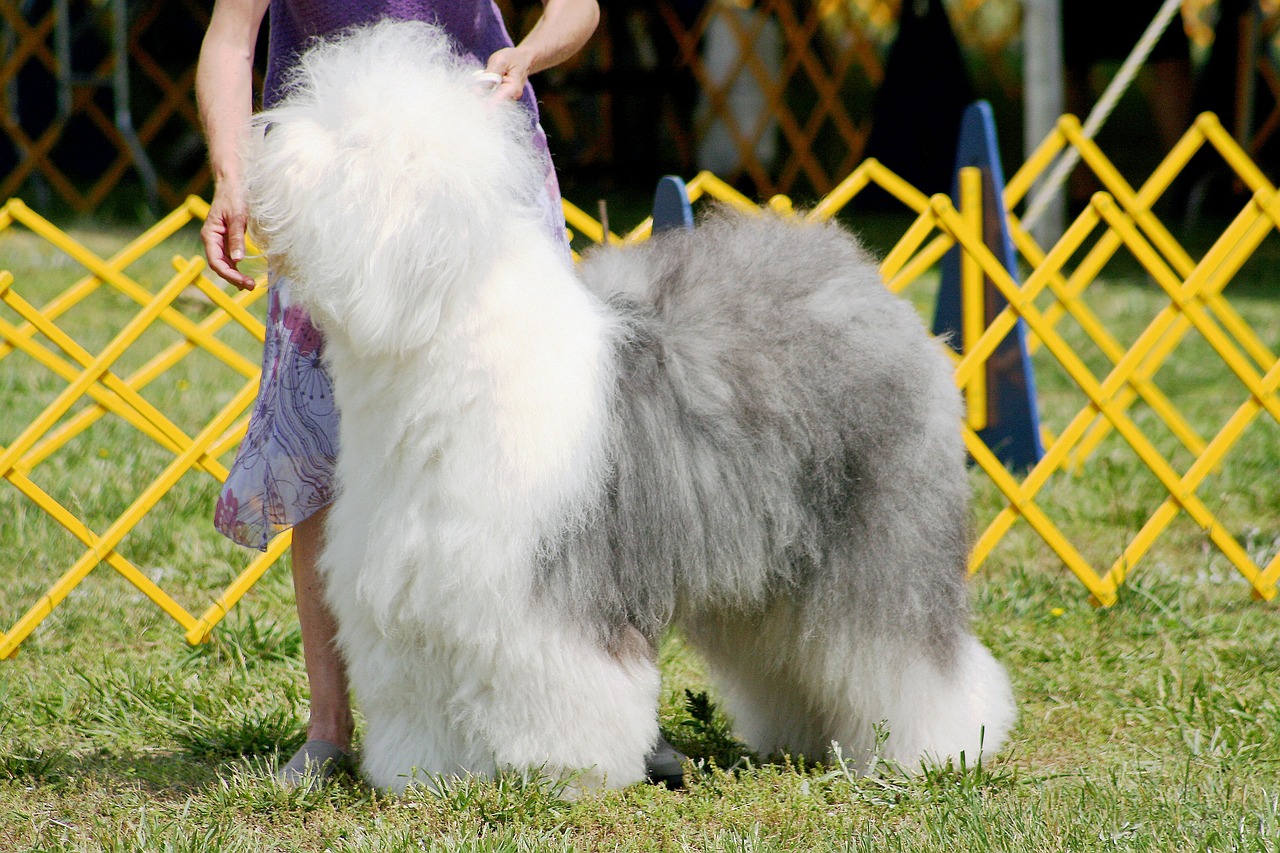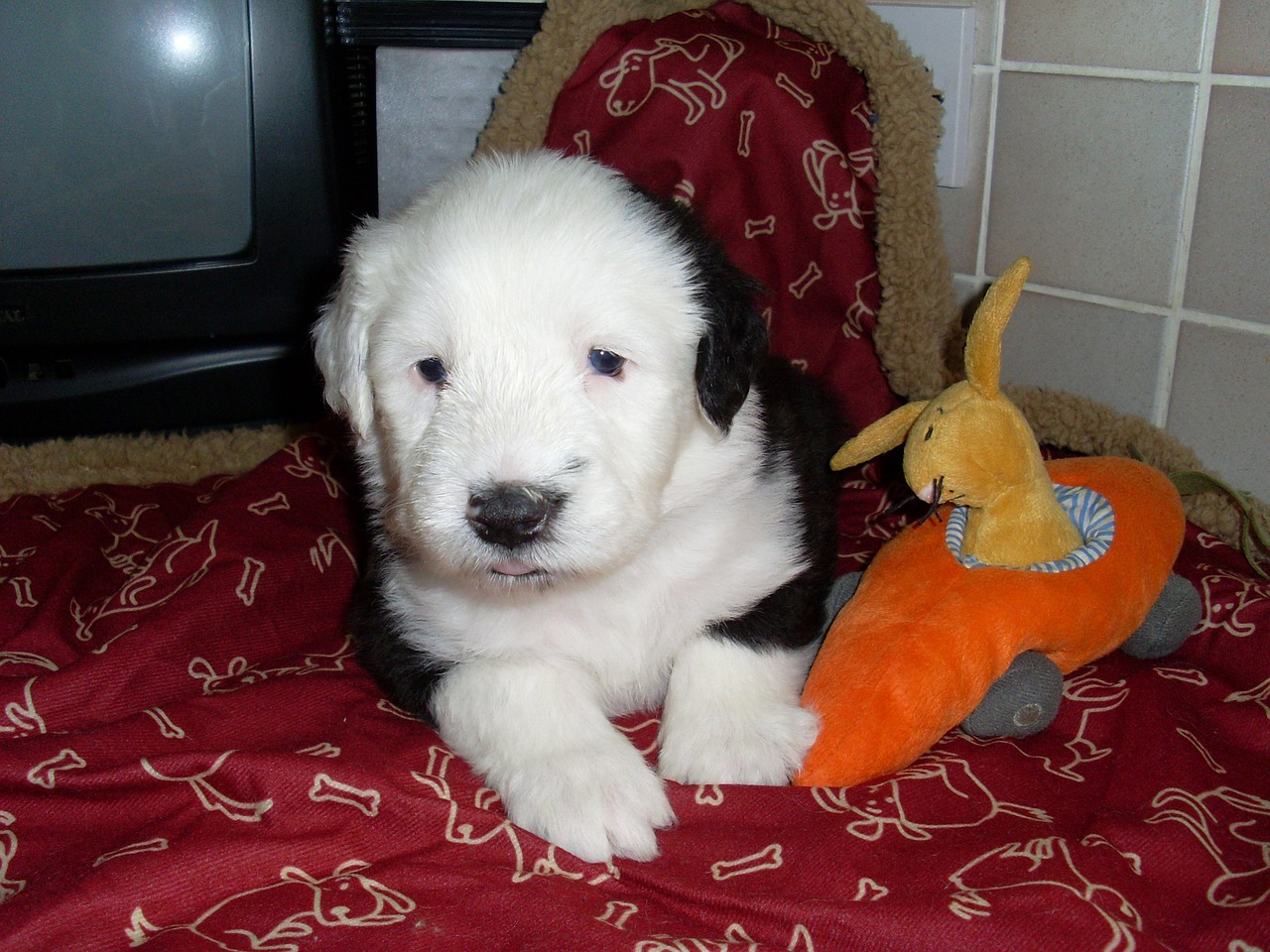The Old English Sheepdog, with its distinctive shaggy coat and amiable demeanor, stands as a beloved and recognizable breed across the globe. Despite its name, the breed’s exact origins are somewhat mysterious, with its development deeply rooted in the pastoral landscapes of England. Known for their herding prowess, Old English Sheepdogs were invaluable to farmers for driving cattle and sheep to market. The breed’s iconic coat, developed for protection against the harsh English weather, and its intelligent, gentle nature have made it a cherished companion beyond its working roots. Over the years, the Old English Sheepdog has transitioned from a farmer’s assistant to a show dog and family pet, retaining its playful spirit and adaptability. This article aims to explore the rich history and origins of the Old English Sheepdog, shedding light on its journey from the fields of England to the hearts of dog lovers worldwide.

The Ancestral Origins of the Old English Sheepdog
The Old English Sheepdog’s origins can be traced back to the early 19th century in the rural areas of Southwestern England. It is believed that the breed resulted from the crossbreeding of various European herding dogs, possibly including the Scotch Bearded Collie and the Russian Owtchar, among others. These ancestors provided the Old English Sheepdog with its robust herding instincts, impressive size, and characteristic long, dense coat. Initially, these dogs were primarily used by farmers to drive cattle and sheep to market, their shaggy coats protecting them from the elements and their herding skills proving indispensable in managing livestock.
Development and Recognition
The Old English Sheepdog began to gain popularity outside of its working role in the late 19th century, particularly among the British nobility. Its unique appearance and gentle, affable nature made it a favorite in dog shows and as a companion animal. The breed was officially recognized by The Kennel Club in the United Kingdom in 1888, marking a significant milestone in its history. This recognition helped standardize the breed and further establish its presence in the show ring and among dog enthusiasts. In the United States, the American Kennel Club (AKC) recognized the Old English Sheepdog in 1885, reflecting its growing popularity across the Atlantic.
The Breed in Modern Times
Today, the Old English Sheepdog enjoys its status as a beloved family pet and show dog, known for its playful demeanor, intelligence, and adaptability. While no longer as commonly employed in its traditional herding role, the breed continues to excel in various canine sports, including obedience, agility, and herding trials, showcasing its versatile nature. The Old English Sheepdog’s distinctive appearance, with its shaggy coat and expressive eyes, along with its friendly and easygoing temperament, make it a cherished companion in homes around the world.
Characteristics and Temperament
The Old English Sheepdog is characterized by its large frame, shaggy double coat, and distinctive “bear-like” gait. Its coat, which can range from gray to blue merle, often covers its face and eyes, adding to its unique and endearing appearance. The breed is known for its intelligent, playful, and adaptable nature, making it an excellent family pet. Old English Sheepdogs are loyal and affectionate with their families but may exhibit a protective streak when it comes to their loved ones. Despite their size, they are gentle and patient, often forming strong bonds with children and other pets.
The Old English Sheepdog’s journey from the pastoral fields of England to the show rings and living rooms around the world is a testament to its enduring charm and versatility. With its origins shrouded in mystery and its development intertwined with the agricultural history of England, the breed has successfully transitioned to a beloved companion, retaining its playful spirit and herding instincts. As the Old English Sheepdog continues to captivate the hearts of dog lovers everywhere, it carries with it the legacy of its ancestors, a symbol of gentle strength and enduring loyalty.
Frequently Asked Questions About The History of Old English Sheepdogs

1. What is the origin of the Old English Sheepdog?
The Old English Sheepdog (OES) originates from the early 19th century in the western counties of England. It was primarily developed as a drover, helping farmers drive cattle and sheep to market. While its exact ancestry is not well-documented, it is believed that the breed was developed from various European herding dogs, possibly including the Scottish Bearded Collie and the Russian Owtchar. The breed’s shaggy coat protected it from the harsh English weather, and its strong herding instinct made it invaluable to farmers and herders.
2. How did the Old English Sheepdog get its name?
The Old English Sheepdog was named for its primary function as a herding dog for sheep. The “Old English” part of its name reflects the breed’s long history and development in England. Initially, these dogs might have been called by various names, but as the breed became more standardized, the name “Old English Sheepdog” became widely accepted. This name highlights both the breed’s heritage and its role in English pastoral life.
3. What roles did Old English Sheepdogs historically serve?
Historically, Old English Sheepdogs served as working dogs, primarily in herding and driving sheep and cattle to market. Their duties involved guiding livestock along roads from the countryside to urban markets. Besides herding, their loud bark and protective nature made them excellent watchdogs on farms. These dogs were valued for their hardworking disposition, intelligence, and adaptability, traits that made them indispensable to farmers and herders.
4. When was the Old English Sheepdog officially recognized as a breed?
The Old English Sheepdog was officially recognized as a breed in the late 19th century. The Kennel Club in the United Kingdom granted official recognition to the breed in 1873, following its growing popularity in England. This formal recognition helped to standardize the breed and promote its presence in dog shows and competitions. The American Kennel Club (AKC) followed suit and recognized the breed in 1888, further establishing its status as a distinct breed in the dog community.
5. What challenges has the Old English Sheepdog breed faced?
Throughout its history, the Old English Sheepdog has faced various challenges, including changes in agricultural practices that reduced the demand for working herding dogs. Additionally, the breed’s large size and extensive grooming requirements have made it less suitable for urban living conditions and less popular among casual dog owners. Despite these challenges, dedicated breeders and enthusiasts have worked to preserve the breed’s characteristics and promote its qualities as both a working dog and a companion.
6. How did Old English Sheepdogs come to be recognized outside of England?
Old English Sheepdogs came to be recognized outside of England through their export to other countries, especially to the United States and Canada, in the late 19th and early 20th centuries. Their distinctive appearance and affable nature quickly made them popular among dog enthusiasts in North America. Recognition by kennel clubs like the AKC helped to standardize the breed internationally and fostered its popularity as a show dog and family pet beyond English borders.
7. What are the distinctive physical characteristics of the Old English Sheepdog?
The Old English Sheepdog is known for its distinctive shaggy, double coat, which can range from gray to blue, with or without white markings. The breed features a strong, compact body, a broad head with a characteristic bear-like shuffle, and a profuse coat that covers the face and eyes. The tail is traditionally docked, contributing to its unique silhouette. Their expressive eyes and ambling gait make them instantly recognizable.
8. What is the temperament of the Old English Sheepdog?
The Old English Sheepdog is renowned for its adaptable, friendly, and intelligent temperament. These dogs are known for their playful, gentle nature, making them excellent companions for families with children. They are protective of their home and family, showing a watchful but not aggressive demeanor towards strangers. The OES enjoys being part of family activities and thrives on interaction and affection. Despite their size, they are often described as clownish and are known for their loving and loyal disposition.
9. Are Old English Sheepdogs good with children and other pets?
Yes, Old English Sheepdogs are generally good with children and other pets. They are known for their gentle, patient, and protective nature, making them excellent family pets. Their playful disposition and tolerance make them well-suited for households with children. Early socialization is recommended to ensure they are comfortable and well-behaved around other pets. Their herding instinct may prompt them to gently herd children and pets, a behavior that can be managed with proper training.
10. How do Old English Sheepdogs perform in dog sports and activities?
Old English Sheepdogs perform well in various dog sports and activities, including obedience, agility, and herding trials. Their intelligence and willingness to please make them trainable and eager participants in these events. OES are particularly adept at herding, a nod to their working dog heritage. They also excel in activities that allow them to use their problem-solving skills and enjoy physical and mental stimulation.
11. What are the grooming requirements for an Old English Sheepdog?
The grooming requirements for an Old English Sheepdog are extensive due to their thick, shaggy coat. Regular brushing, at least a few times a week, is necessary to prevent matting and tangling. Professional grooming every 6-8 weeks is recommended to keep their coat in good condition. In addition to coat care, regular attention should be given to their nails, ears, and teeth to maintain overall health. The grooming process provides an opportunity for bonding but requires time and commitment.
12. How long do Old English Sheepdogs typically live?
Old English Sheepdogs typically have a lifespan of 10 to 12 years. With proper care, including a balanced diet, regular exercise, and routine veterinary check-ups, OES can enjoy a healthy and active life. Genetic factors, lifestyle, and the quality of care provided by their owners can influence their overall health and longevity.
13. What health issues are common in Old English Sheepdogs?
Old English Sheepdogs are prone to certain health issues, including hip dysplasia, cataracts, and hypothyroidism. They may also be at risk for breed-specific conditions like hereditary deafness and Primary Ciliary Dyskinesia (PCD), a lung disease. Responsible breeding practices and health screening can help minimize the risk of these conditions. Regular veterinary care is crucial for early detection and management of health issues.
14. How much exercise do Old English Sheepdogs need?
Old English Sheepdogs need moderate to high levels of exercise to maintain their health and happiness. Daily walks, play sessions in a secure area, and mental stimulation activities are essential for keeping them active and engaged. Their herding background means they enjoy activities that involve running and problem-solving. Adequate exercise helps prevent boredom and potential behavior problems, ensuring a well-adjusted and content pet.
15. How can prospective owners ensure they are getting a healthy Old English Sheepdog puppy?
Prospective owners can ensure they are getting a healthy Old English Sheepdog puppy by researching and selecting a reputable breeder who follows responsible breeding practices. Reputable breeders conduct health screenings and genetic testing on their breeding dogs to minimize the risk of hereditary conditions. They should provide health clearances for both parents and be transparent about any health issues in the puppy’s lineage. Visiting the breeder’s facility, meeting the puppy’s parents, and observing the conditions in which the puppies are raised can offer valuable insights into their health and temperament.
 Toledo, United States.
Toledo, United States.